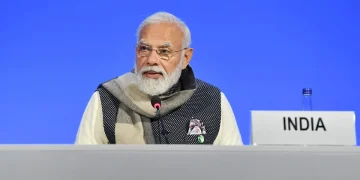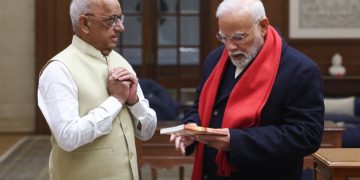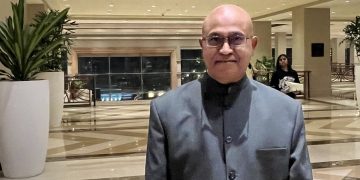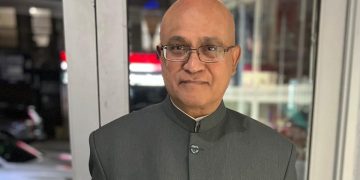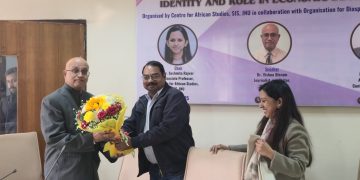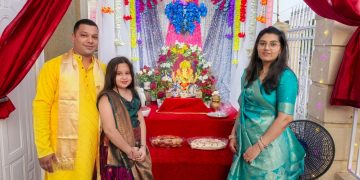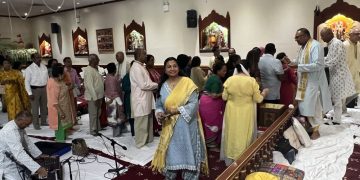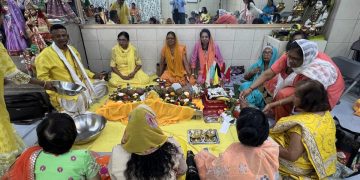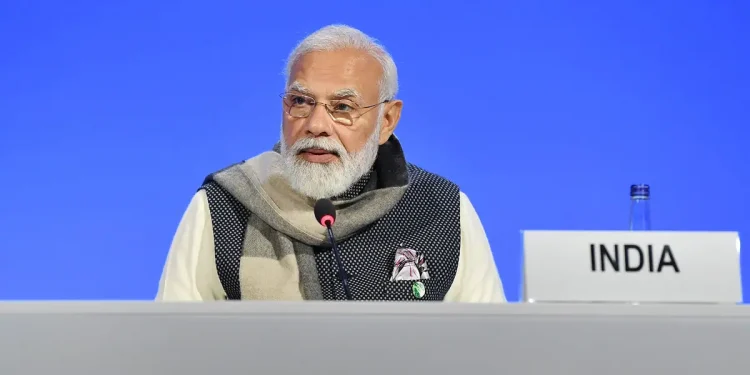(By Dr. Aman Singh Maharaj, Durban – South Africa, August 2023).
(Dr. Aman Singh Maharaj is an engineer, economist and entrepreneur, and, of late, also a writer of fiction, including his debut novel: ‘A Dalliance with Destiny’. He also writes for various media houses globally.)
There is a growing sense of unease between the average Hindu and Muslim Indian Diaspora when it comes to discussions on Narendra Modi and Kashmir. Whilst there are sporadic arguments in South Africa, people leaving WhatsApp Groups, etc. in protest, either for or against Modi, whenever he is mentioned; thankfully, the situation has not reached the communal violence proportions as found in England recently, specifically, in Leicester. It will be woeful were the South African Indian community, including Hindus, Muslims and Christians, not form a united grouping.
Based on anecdotal evidence, there is arguably considerable support for Narendra Modi in South Africa from the Hindu community, whilst their Muslim brethren seem to have a seeming anger instead. The Hindus, many noting the ire of Modi’s detractors, tend to show their support for the current Indian Prime Minister in ‘hushed’ tones, save for a few ‘bravehearts’. The Muslim community and left-leaning Hindus have been much more vociferous, showing their opposition through media platforms or through marches.
Regardless of which party may be wrong or right, any bifurcation of the 1.5 million Indian community in South Africa, comprising of 41% Hindus, 25% Muslims, 24% Christians and 10% Other Religions (Parsis, Sikhs and Buddhists), in a country of 60 million people, bodes for terrible consequences. In the recent July Riots of 2021, Indians of all religious groupings came together to stave off what seemed to be targeted racial profiling, putting up a remarkable show of strength. But this would not have been sustained, based on mere numbers alone. Arguably, the unity of Indians in South Africa is paramount in order to entrench its foothold in the country.
Concomitantly, when it comes to matters of polemic content, it is best to remove the emotion from the discussions, and let statistical evidence guide the debate. It would be glib to state that there is a strong backing for Pakistan from the Muslim community in South Africa, whilst the Hindus identify with India, in turn, if the spectator support at an Indian-Pakistan cricket match can be used as a measure of the polarity in thinking. The question then arises: Do we think along tribal lines, identifying more with religious affiliationsthan ancestral origins? It should be noted that the majority of Indians in South Africa, including Muslims, Christians and Hindus, have forefathers who hail primarily from the states Uttar Pradesh, Bihar, Gujarat, Tamil Nadu, Andhra Pradesh and Telangana, all a part of modern day India. If there are any ancestral homesteads in Pakistan, this is probably extremely negligible.
The seeming local support for Pakistan then, versus India, is a somewhat questionable one. Whilst India does have incidents of anti-Muslim violence, in a country of 1,5 billion people, the world’s most populous nation, these become miniscule, without seeming trite; much lower than the incidents of anti-Hindu incidents in Pakistan, or the anti-Sikh attitude in Afghanistan. However, this is keeping in mind that even a single incidence of violence against a Muslim in India is unacceptable.
So, what do the statistics indicate? The population of Hindus in Pakistan in 1950, after Partition and the migration it brought about, is officially estimated to have been around 12.9%, although some quarters may argue it was double that. As of 2021, they now comprise 0.9%. What has happened to the missing 12%? It is probably unlikely that the Hindu in Pakistan is less fecund than his counterpart in India, considering the cultural commonalities. There are a number of reports from independent human rights organisations that raise the issues of forced conversions, ‘Love Jihad’, and anti-Hindu murders in Pakistan; a country that, by law, does not allow a Hindu to become Prime Minister. (Article 91(3) of Pakistan’s Constitution states that the Prime Minister must be “a Muslim and not less than forty years of age.”). In a similar ethos having ‘lesser citizens’, the Hindu community of Islamabad had to get a court directive to approve the construction of a temple in as recently as 2020. The reality is that the statistical evidence suggests there has been a systematic ethnic cleansing of Hindus and Sikhs in Pakistan, Afghanistan and Bangladesh.
It is this very same ethos of relegating Hindus and Sikhsto being violently suppressed ‘citizens’ in these countries, which saw the Modi Government fast-track the citizenship process for refugees, escaping such torment. The fact that Muslims from Pakistan, Bangladesh and Afghanistan were not given the same ‘opportunity’ in India, which saw many sectarian marches being staged against the Indian government on a global scale. In no way did this new Bill restrict Muslims from other countries becoming Indian citizens. To include Muslim refugees in the new Bill would imply that they were statistically being targeted in Pakistan, Bangladesh and Afghanistan, which would be asomewhat absurd suggestion.
On the other hand, India has seen Muslims asPresident, politicians, judges, a cricket captain, top tier Bollywood actors (the latter two sectors almost being ‘religions’ on their own), and wealthy industrialists. Additionally, in 1950, the Muslim population in India stood at around 10%, then growing to 15% in 2023. This needs to be juxtaposed against the decline of Hindu numbers in Pakistan. The question that then emerges, as to who is collectively safer (and happier)? The Muslim in India or the Hindu in Pakistan?
Why then, is there a growing call for Indian Kashmir to be given to Pakistan from some members of the Indian Diaspora? The fact that Kashmir is now a majority Muslim state does not remove the historical importance of the state to Hindus, itself named after a Hindu sage called Kashyap. Neither does their call acknowledge the ethnic removal of 150000 Kashmiri Pandits, although some say the figure is closer to 500000, who were the original inhabitants of the state.
Kashmir’s integration can be traced back to the princely state’s accession to India in 1947. During the partition of India, princely states were given the choice to either joinIndia or Pakistan, based on religious demographics and the wishes of their rulers. The then Maharaja of Kashmir, Hari Singh, chose to accede to India. This accession was carried out in accordance with the legal framework of the time, specifically the Indian Independence Act of 1947, which provided for the accession of princely states.
The legality of this accession has been recognised by the international community, including the United Nations. Furthermore, the Instrument of Accession signed by the Maharaja of Kashmir explicitly stated that matters relating to defence, external affairs and communications would be under the jurisdiction of the Indian government, while the state would have autonomy in other areas. This arrangement was in line with the agreed-upon principles of accession for princely states at the time.
Naturally, but not necessarily democratically, any plebiscite in the state would be decided upon religious lines. In the absence of any predictive tools, history then becomes the best prognosticator of future events. And the truth is that the remaining Hindus of Kashmir are likely to be subjected to the same conditions as the current Hindus of Pakistan, were Kashmir to change sovereignty.
The reality is that the Abrogation of Article 370 in Kashmir has seen tremendous economic benefits to the state, including huge swells in tourism numbers, increased foreign and national investment in the state, and many employment opportunities created. The reality is that the biggest investor for 2023 in Kashmir, post the Abrogation, has been the UAE company, Emaar, with USD60 million, to create 8000 new jobs. In actual fact, many of the Arab countries have withdrew their support for a state referendum to decide upon where Kashmir belongs, clamouring to build economic and political ties with India instead, the world’s fastest growing large economy, regardless of the devastation caused by Covid 19.
Comparing this to Pakistan’s dwindling economy, annual inflation of 32% and unstable political leadership, it defies belief that religious doctrine alone should drive the ethos of where Kashmir rightfully belongs. Whilst there may be cases of suppression by the Indian army in Kashmir, and the killing of innocents is not improbable in areas of insurgency, whether they be Hindu or Muslim, this would still be detestable. However, it is not without the rightful need of a nation to protect its territory, as the state continues to be a well-spring for violent insurgency, sometimes sponsored by Pakistan, which has been extensively reported by many espionage agencies globally.
Likewise, the continued attack on Modi and his government is equally surprising; the basis of which is linked to the Gujarat Riots of 2002. Whilst this was a tragic event, it is important to note that multiple investigations and judicial inquiries have taken place. In 2012, the Special Investigation Team (SIT), appointed by the Supreme Court of India, submitted its report on the Gujarat Riots. The SIT, after conducting a thorough investigation, stated that there was no prosecutable evidence against Narendra Modi, who was the Chief Minister of Gujarat at the time of the Riots. The Supreme Court accepted the SIT’s report and closed the case against Modi.
It is important to note that the SIT was an independentbody appointed by the Supreme Court, comprising experienced investigators and legal experts. The Supreme Court’s decision to accept the SIT’s report indicates that Modi was not found guilty in relation to the Gujarat Riots at a judicial level.
The then general counter-argument is that Modi influenced the outcome of this investigation by the SIT. The reality, though, is that in 2012 and prior, during the actual investigative work by the SIT, it was the Indian National Congress (INC) that was in power at the time. If anything, the INC would have surely sought to have Modi prosecuted based on political machinations alone. However, in a strong case for democracy, the investigation and legal proceedings were carried out under the scrutiny of independent institutions, including the judiciary. The Supreme Court-monitored processaimed to ensure transparency and fairness, and the SIT’s findings were based on actual evidence and legal considerations.
The outcome of the case against Narendra Modi by the SIT indicated that no prosecutable evidence was found against him in relation to the Gujarat Riots. Additionally, official estimates state that approximately 790 Muslims and 254 Hindus were killed during the Riots, meaning a quarter of all deaths were actually Hindu, still a significant number to attribute to a mere conspiracy theory.
The recent BBC documentary that targets Modi as being the mastermind behind the Riots saw it being denounced by the Prime Minister of England himself, as well as other leaders of large, global democracies. Despite all the tenets of skilful investigative journalismrequired, the calamitous investigations by the BBC doesnot supersede the rigorousness of an independent judiciary. The plain bias of the left-leaning BBC is also in question, considering that it has never done any documentary whatsoever on Churchill’s creation of the Bengal Famine that saw millions die, or raise the issue of ownership of the crown jewels that sit in the Tower of London, which rightfully belongs to India.
Further, in the diasporic attacks on Modi allegedly being some puppeteering mastermind behind the Gujarat Riots, there is seemingly no credence given to the revolts being sparked by a train fire incident in Godhra, where a number of Hindu pilgrims returning from Ayodhya were killed. The train fire was reportedly caused by a mob attack on the train, although the exact circumstances and motivations behind the incident remain a subject of debate. This train fire, in turn, is said to be somewhat predicated on the razing of the Babri Masjid in Ayodhya when the BJP came into power, from where the pilgrims were returning.
The Mosque was built around 1528 by the Moghul Emperor, Babur, on the very spot where Lord Ram, seen as an incarnation of God by nearly one billion Hindus, was born. From as early as the Nineteenth Century, court processes were promulgated to have the location return to the original landmark. It was to be only in 2019, perhaps two centuries later, that, through a state inquest, the locale was finally returned to the Hindus,where the final, key witness was an actual Muslim historian from the Architectural Society of India, who confirmed the original Hindu foundation of the place.
No other religion would ever accept the denigration of its gods or deities, especially in a country where it is the majority. The very same action was taken by Moghuls where Lord Krishna was born in Mathura, and places of supreme religious importance, such as the Kashi Vishwanath Temple in Varanasi, also currently under investigation. Which other country would’ve followed such a lengthy, independent and democratic process in re-establishing the rightful religious significance of asite? Now, compare this arguably protracted approachof India’s to that of Pakistan’s, which, by law, did now allow any new temples to be constructed until 2020. Why then, is there a difference in the standards of fairness used to treat people of various religious persuasions? The stark reality is that the ultimateinstigator of the Gujerat Riots would surely be the Moghuls themselves, despite the timeline, whodestroyed religious icons of tremendous significance to Hindus with absolute tyranny and impunity.
However, even the Moghuls’ reign of terror is whitewashed by modern India’s detractors. Common, facile arguments include benign statements: that the Moghuls came to India as refugees and not conquerors, an absolutely asinine thought. It is along the same ethos that there is a huge denial from such disparagers that the Mumbai Terror Attacks of 2008 were led by ISI trained agents from Pakistan, that Dawood Ibrahim, underworld don and coordinator of the 2003 Mumbai bombings, is not alternatively holed up between the UAE and Pakistan.
 There is a vilification of the BJP’s Hindutva ideology,which is more synonymous with a strong sense of nationalism and patriotism than targeting other religions, especially after so many centuries of being annexed, in whole or in part, by the Greeks, Portuguese, Moghuls, Turks, Dutch, French and English. Even if India follows Hindutva at a national level, how different is it from European countries having a Christian ethos, or Islamic countries practicing Sharia Law? Why is there a difference in expectations of self-determination of a sovereign state? Why would this be unacceptable, as long as the rights of minorities are respected in law andin practice? Furthermore, one cannot draw a normative argument and suggest a generalised suppression of religious minorities in India based on sporadic incidents, which is the actual case. Conflicts along ethnic lines in India does not supersede the rest of the globe. But Indian certainly gets more mileage in the leftist press globally. It would seem that one’s opinion is based on which newspapers one reads or news channels one watches, these days.
There is a vilification of the BJP’s Hindutva ideology,which is more synonymous with a strong sense of nationalism and patriotism than targeting other religions, especially after so many centuries of being annexed, in whole or in part, by the Greeks, Portuguese, Moghuls, Turks, Dutch, French and English. Even if India follows Hindutva at a national level, how different is it from European countries having a Christian ethos, or Islamic countries practicing Sharia Law? Why is there a difference in expectations of self-determination of a sovereign state? Why would this be unacceptable, as long as the rights of minorities are respected in law andin practice? Furthermore, one cannot draw a normative argument and suggest a generalised suppression of religious minorities in India based on sporadic incidents, which is the actual case. Conflicts along ethnic lines in India does not supersede the rest of the globe. But Indian certainly gets more mileage in the leftist press globally. It would seem that one’s opinion is based on which newspapers one reads or news channels one watches, these days.
Finally, is it not a sin to denigrate a man, based on mere hearsay? Modi has once again put India on a global map after the country being repeatedly plundered for so many centuries by so many conquerors. For his supporters, he has gone beyond just statesman status, and has become almost a messiah. The flourishing of India, the strides in infrastructure development and the destruction of corruption under his leadership, the great advances in medicine, i.e. vaccine technology that made it affordable to the whole world during Covid 19, the immense respect on the global stage; these are all attributable to a remarkable man, who has had no personal enrichment in the process (and a very remarkable timeframe). He leads a country where he is actually well-respected across all religious communities, save for a few leftist detractors, which normally falls under the aegis everyday politicking.
India is a country that has over 210 million Muslim citizens, so it is absolutely preposterous to even suggest that they do not have any place in the country. By far, Modi even has strong support in the Muslim community of India itself. Strangely, the main opposition to him seems to be coming from the Diaspora itself.
As long as faith-based tribalism is the platform upon which opinions are generated, and pain is felt on behalf of another, then humanity is lost in process, and this concept applies to all doctrines. Finally, reverting to the original premise, in South Africa, we are just too small a community, collectively as Indians, to create divisions based on religious lines. In South Africa, stemming from our own Durban Riots of 1949, the Inanda Riots of 1985, and the July Riots of 2021, one ethic minority seemed to be targeted more so than any other. Add in the Ugandan Expulsion of Indians under Idi Amin, there can be parallels drawn, dramatic as it may seem. It would simply be foolhardy to attack the head of the onlyforeign country to raise an actual diplomatic alarm during the 2021 Riots in South Africa, especially if such opposition is not underpinned by verified facts.
